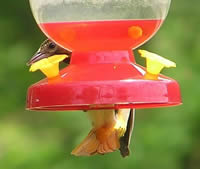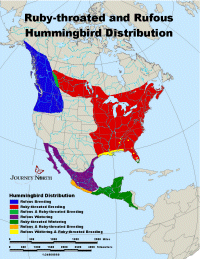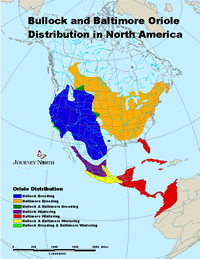Week Ending April 30, 2009
What
can you learn about migrations from other observers? Read these reports,
then discuss the question at the end.
April 25: Saunderstown, RI
(41.52 N, -71.46 W)
A male arrived this evening, checking out both the hummer
feeder and the oriole feeder. He even buzzed my head. >>
April
26: Madison, OH
(41.77 N, -81.06 W)
What a great day! An oriole came this morning
and then on and off all day. This evening I saw my first hummingbird of
the year. >>
April 27: Pickett,
WI
(43.90 N, -88.71 W)
We have several 6 feeders up ready for them. I got those
feeders ready early based on the trends. The orioles have been enjoying
these for 2 days now! >>
April
27: Lawson, MO
(39.45
N, -94.18 W)
Finally my first 2009 rubythroat sighting and also my first
first oriole sighting today. I've been waiting and watching! Now spring
is here. >>
April 28: Whitewater, WI
(42.80 N, -88.75 W)
I have been looking for the first ruby-throated hummingbird
for the past 2 weeks. Today I saw the first one: a male eating at a feeder.
He was not frightened by me and I was within 5 feet of him on the feeder.
Now I'm watching for the first Baltimore oriole. >>
April
26:
Geneseo, IL
(41.48
N, -90.18
W)
I saw the first male oriole at the hummingbird feeder,
then it went to the oriole feeder. (Sighting report from our Oriole
migration map.)
Think:
What do you think ruby-throated hummingbirds and Baltimore orioles have
in common?
|
Who
is this stranger drinking from the hummingbird feeder? Click
to enlarge. Then read these reports from Journey North observers!
Photo: © Jean English |

For
Your Journal
Each week, choose a favorite hummingbird sighting and record your thoughts
in your journal. >>
Did
you know?
You can find all observations reported
this week in the sightings database
and on the rufous and
rubythroat migration
maps.
Dig Deeper: Once you've answered, look at these facts about hummingbirds and orioles. What more would you add to your answer? Why do you think they arrive up north about the same time?
| Ruby-throated
Hummingbirds |
Baltimore
Orioles |
| Enlarge:
The red shows the ruby-throated hummingbird's breeding range. (The
green shows its winter range.) |
Enlarge:
The gold shows the Baltimore oriole's breeding range. (The red shows
its winter range.) |
| What
They Eat (Diet) |
|
| Insects,
flower nectar |
Insects,
flower nectar, small fruits |
| Where
They Live (Habitat) |
|
| Wooded
areas, suburban parks and gardens, near streams |
Wooded
areas, suburban areas with shade trees, near streams |
| Migration
Notes |
|
| Cross
the Gulf of Mexico on journey north from Central America. |
Cross
the Gulf of Mexico on journey north from Central America. |
| Take
8-10 weeks to migrate north. |
Take
2-3 weeks to migrate north. They make a big push once leaves come
out. |
| Can
eat many types of tiny flying insects and sap from sapsucker holes.
So even in unpredictable weather on their long migration, they can
find food. |
Require
much larger insects, like caterpillars. These don't hatch until
leaves come out. So orioles wait until then, and then make a fast
final push north. |
| Rubythroats arrive in northern breeding grounds about the same time as orioles: When food sources are available there. | Orioles arrive in northern breeding grounds about the same time as rubythroats: When food sources are available there. |


